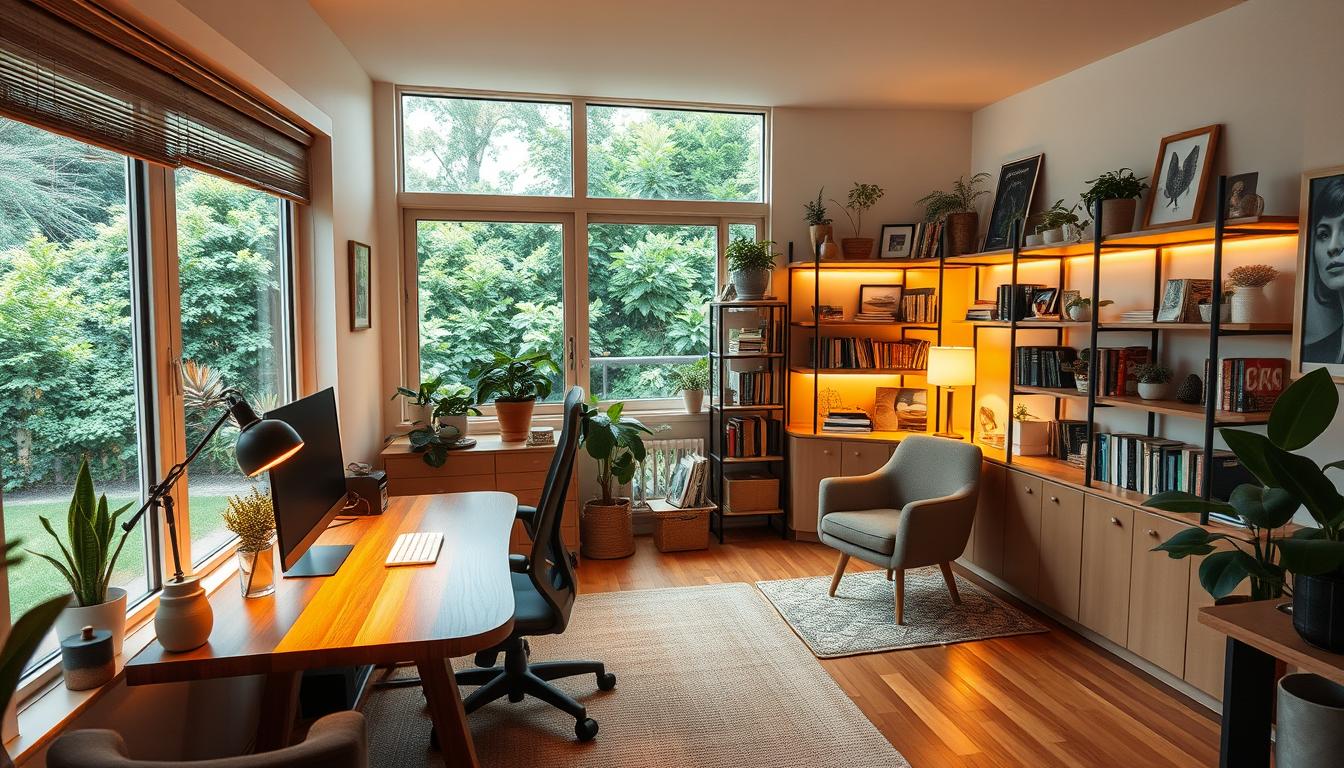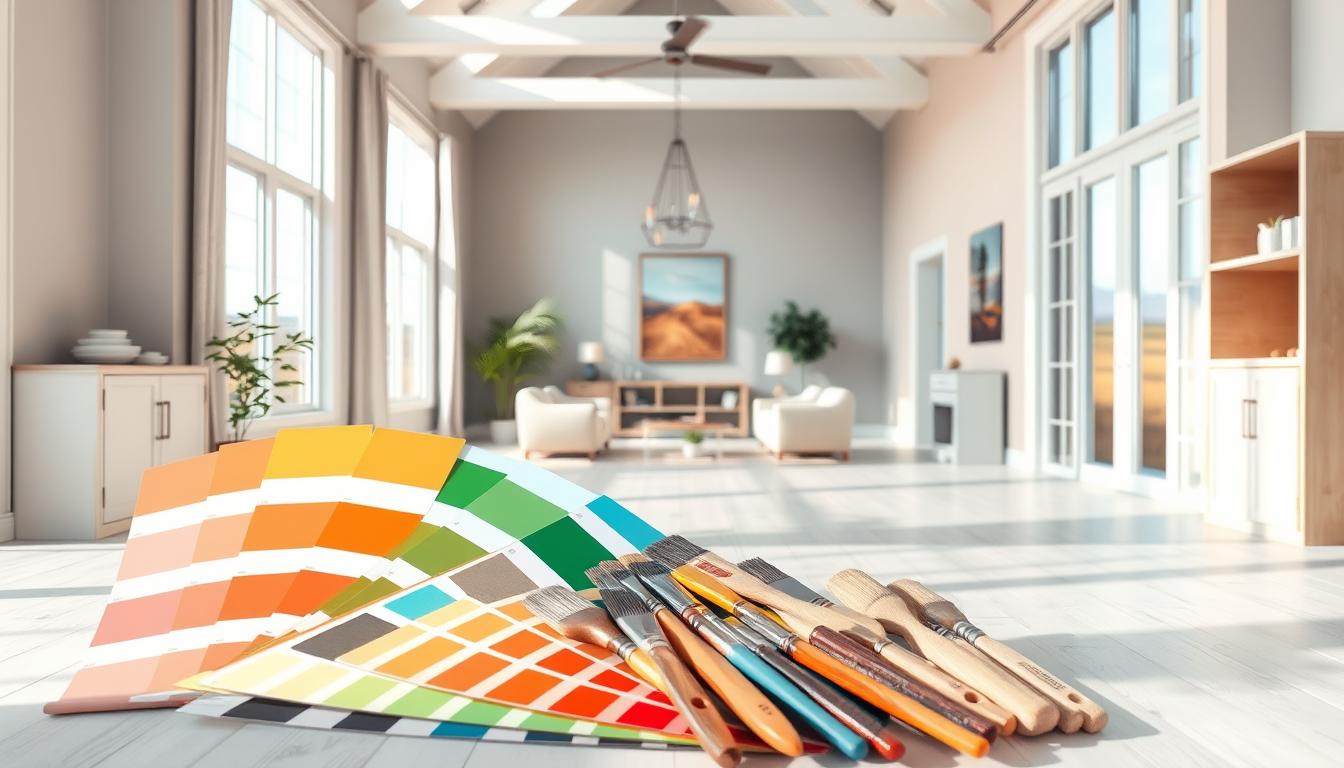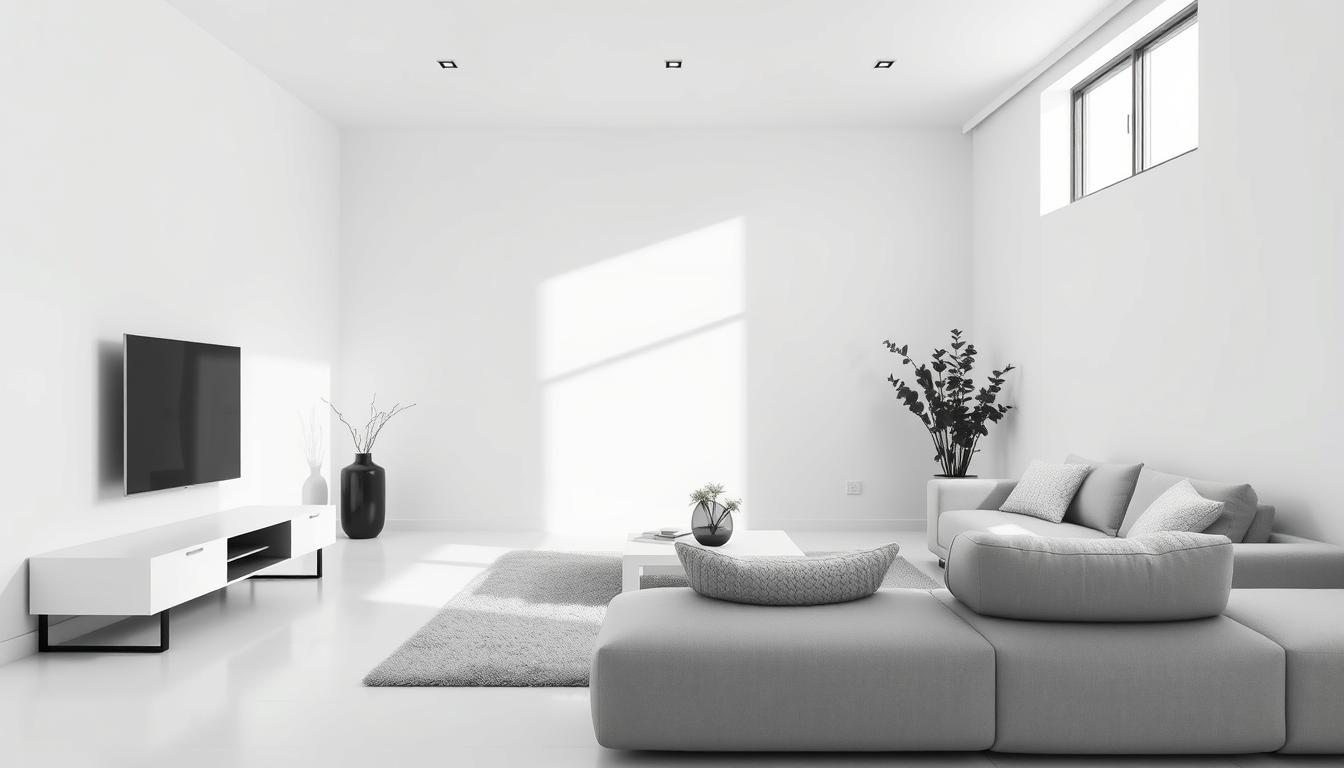More people work from home than ever before. A well-designed home office is key for staying productive and stylish. Studies show a dedicated space can increase work efficiency by up to 20%.
We’ll share our best tips for designing a home office that fits your needs and style. We’ll talk about picking the right spot, adding technology, and choosing ergonomic furniture.
Follow our advice to make a workspace that’s both useful and beautiful. We aim to help you create a home office you’ll enjoy working in.
Key Takeaways
- Optimize your workspace for productivity
- Choose the right furniture for comfort and efficiency
- Incorporate technology for seamless workflow
- Personalize your space to boost creativity
- Consider ergonomic design for better health
Understanding the Importance of a Dedicated Home Office Space
Today, work and personal life often mix together. A dedicated home office space helps keep things clear and focused. With more people working from home, having a clear workspace boosts productivity and happiness.
Benefits of a Functional Workspace
A good workspace makes work better. It offers a stylish home office design that boosts creativity and productivity. Key benefits include:
- Increased efficiency from a well-organized space
- Better work quality with fewer distractions
- A professional setting for video calls and meetings
The Impact on Productivity
A dedicated home office boosts productivity. It lets us create a modern home office inspiration that helps us work better. With the right tools and space, we can:
- Focus on tasks better
- Manage time well, avoiding delays
- Stay motivated and on track with goals
Balancing Work and Home Life
A dedicated home office is great for work-life balance. It lets us create a creative workspace design that’s separate from living areas. This helps us:
- Set clear work and personal time boundaries
- Lessen stress from working at home
- Improve our life quality by enhancing our work space
Understanding the value of a dedicated home office is key. It helps us create a space that’s not just useful but also inspiring and good for our well-being.
Defining Your Home Office Style
Creating your home office style is more than just looks. It’s about making a space that boosts your productivity and creativity. Since you’ll spend a lot of time here, its design affects your work and happiness.
Choosing a Design Aesthetic
Choosing your home office decor ideas sets the mood for your space. Think about your home’s style and how your office can match it. You might go for a modern, simple look or a cozy, traditional vibe. Office interior design tips suggest adding things that show your taste, like art, rugs, or special furniture.
Integrating Personal Style
Making your home office feel like your own is key. Add personal items like family photos, collectibles, or quotes that inspire you. When designing a small home office layout, mix personal touches with practical items to keep it tidy.
The Role of Color Psychology
Color psychology is important in designing a productive home office. Colors can change how you feel and work. For example, blue helps you focus, while yellow boosts creativity. Picking the right colors can make your work better and your space more efficient.
By thinking about your style, personal touches, and color, you can make a home office that looks great and works well.
Selecting the Right Location in Your Home
The spot where you set up your home office matters a lot. It affects how well you work and how comfortable you feel. There are many things to think about when picking a place.
Factors for Choosing a Room
Think about the room’s purpose, size, and layout when choosing. You want a quiet, private spot with no distractions. It’s best if the room has a door that can close to keep your work area separate.
Key Considerations:
- Proximity to main living areas
- Availability of natural light
- Noise levels
- Potential for distractions
Natural Light Considerations
Natural light makes your workspace more inviting and healthy. It boosts your mood and energy. Try to pick a room with lots of natural light.
Minimizing Noise and Distractions
A quiet space is key for being productive. Think about where your office is in relation to busy or noisy areas. Soundproofing can also help reduce distractions.
| Distraction | Solution |
|---|---|
| Noise from living areas | Use soundproofing materials |
| Family members interrupting | Establish clear work hours |
| TV and entertainment noise | Place office away from entertainment areas |
By thinking about these points, you can make a home office that works well and feels good. This will improve your work life.
Essential Furniture for Your Home Office
Setting up a home office that’s both useful and comfy needs the right furniture. The right pieces can make you work better and avoid discomfort or injury.
When picking furniture for your home office, focus on key elements. A well-thought-out workspace boosts your efficiency and well-being.
Ergonomic Desk and Chair Options
Choosing ergonomic office furniture is key for comfort during long hours. An ergonomic desk and chair prevent back strain and improve posture. Look for a chair that adjusts in height and has good lumbar support. For desks, consider ones that let you sit or stand.
The Importance of Storage Solutions
Good home office organization solutions keep your space tidy and organized. This includes filing cabinets, shelving, and desk organizers. Having a place for everything reduces distractions and boosts focus.
For more tips on organizing your home office, check out our top interior home design tips. They offer inspiration for a stylish and functional space.
Additional Furniture for Comfort and Functionality
There are more furniture pieces that can make your home office better. Think about adding a cozy reading nook or a creative workspace design with plants or a vision board. These can make your space more welcoming and inspiring.
By picking the right furniture for your home office, you can make a space that’s both comfy and productive. The goal is to find a balance between being useful and expressing your style.
Optimizing Your Home Office Layout
Improving your home office layout can really boost your work efficiency. A well-thought-out layout not only makes you more productive. It also makes your workspace more comfortable.
Creating a Workflow-Friendly Space
To make a space that works well for you, know your work habits. Find out which tasks you do most and set up your space to fit those needs. For example, having your desk by a window can help you stay focused.
Think about the “work triangle” idea. This means arranging your main work spots (like your desk and filing cabinet) in a triangle. This layout cuts down on walking and makes work easier.
Zoning Different Work Areas
It’s important to separate areas for different tasks. Make different zones for working, reading, and storing things. This helps keep your space organized and focused.
In small offices, use furniture that does more than one thing. For example, a storage ottoman can be a seat and a place to store things.
| Zone | Purpose | Essential Elements |
|---|---|---|
| Work Area | Primary workspace | Desk, ergonomic chair, task lighting |
| Storage Area | Supply storage | Shelves, filing cabinets, storage bins |
| Relaxation Nook | Break and relaxation | Comfortable seating, reading light, plants |
Utilizing Vertical Space Effectively
Using vertical space well helps keep your office tidy. Put up shelves and storage that reach the ceiling to use every inch.
Think about using wall-mounted desks or foldable tables. These save floor space, which is great in small offices.
By following these tips, you can make a home office that’s both useful and nice to look at. This will help you work better and enjoy your time at work more.
Incorporating Technology into Your Design
The modern home office is more than looks; it’s about using tech to boost productivity. When designing our home offices, we should think about how tech can make our work better. It can help us stay focused and work more efficiently.
Essential Tech Gadgets for Efficiency
To make our home office efficient, we need the right tech. High-speed internet is essential, along with smartphones and laptops that handle our tasks well. Noise-cancelling headphones help us concentrate, and external monitors give us more screen space to work on.
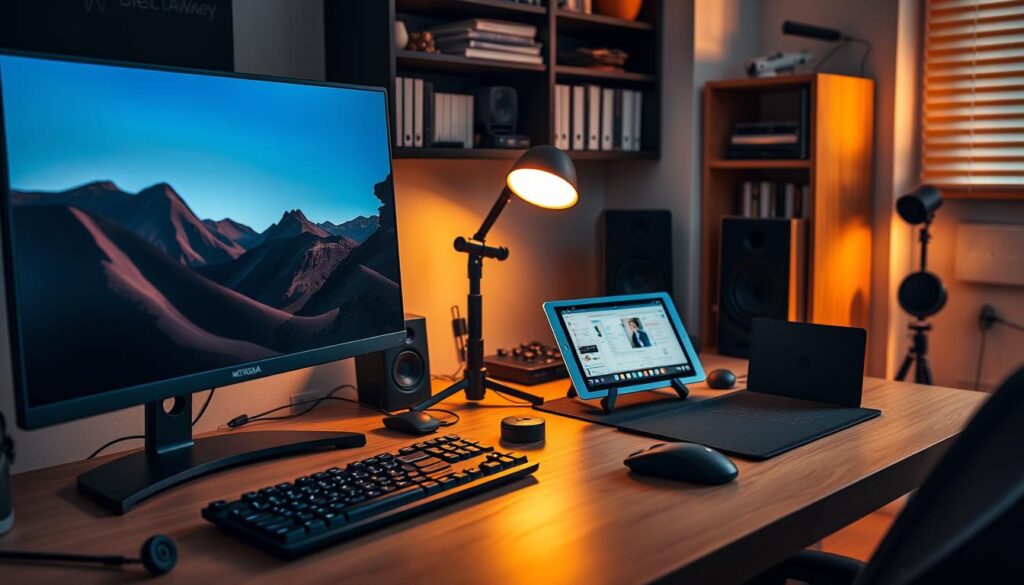
Wiring and Cable Management Tips
More tech means more cables and wiring. To keep our workspace neat, we can use cable ties and cable organizers. Wireless charging pads also help by cutting down on desk cables.
- Use cable ties to secure cables to our desk or under it.
- Invest in a cable management box to hide excess cables.
- Consider a wireless keyboard and mouse to reduce clutter.
Smart Home Devices for Productivity
Smart home devices can make our workday easier by automating tasks and making our space comfy. Smart speakers with voice assistants help us stay on schedule. Smart lighting adjusts to our needs, and smart thermostats keep our office at the perfect temperature.
By adding these tech features, we can make our home office not just functional but also a comfortable and efficient space.
Designing for Comfort and Wellness
Creating a home office that focuses on comfort and wellness is key for our health and productivity. A well-designed space can lower discomfort, boost our mood, and make us more efficient.
Importance of Ergonomics
Ergonomics is crucial in making a comfy home office. Ergonomic office furniture helps avoid body strain, promoting good posture and lowering injury risks. When picking furniture, look for adjustable pieces that fit your needs.
- Choose an ergonomic chair with proper lumbar support.
- Select a desk that allows you to work with your elbows at a 90-degree angle.
- Position your monitor directly in front of you, at a distance of about 20-25 inches.
Incorporating Plants and Natural Elements
Adding plants and natural elements to your home office can greatly improve your well-being. Plants clean the air, reduce stress, and uplift our mood. Think about adding a snake plant or a spider plant to your space.
Temperature and Air Quality Considerations
Keeping a comfortable temperature and good air quality is vital for a productive home office. Make sure your space is well-ventilated. Also, think about using an air purifier to clean the air.
- Keep your home office at a comfortable temperature between 68-72°F.
- Use an air purifier to improve indoor air quality.
- Consider adding a humidifier to maintain a healthy humidity level.
By adding these elements, you can make a home office that supports your comfort and wellness. This leads to a more productive and healthy work environment.
Personalizing Your Home Office
A personalized home office shows who you are and makes work better. It becomes a place where you can be inspired and motivated. This makes your workspace both useful and fun.
Displaying Artwork and Personal Items
Adding your own touches makes your office feel more like home. Think about showing family photos, artwork, or collectibles that make you happy. These items add comfort and make your space truly yours.
Creating a Vision Board
A vision board helps you see your goals clearly. It keeps you focused and driven. To make one, use magazines, scissors, and glue to cut out images and words that mean something to you. Then, arrange them on a board in a way that feels right to you. Hang it where you can see it every day.
Customizing Your Workspace with Accessories
Accessories are key to making your office your own. Think about adding decorative items, plants, or unique storage solutions that show your style. These not only look good but also make your space more practical. For instance, a fancy vase can add elegance, while a fun mousepad can add personality to your desk.
By choosing and using these personal touches, you can make your home office inspiring and useful. This will help you work better and feel happier about your job.
Lighting Solutions for Home Offices
Lighting is key in a home office. It boosts productivity, cuts eye strain, and makes work better. When setting up your office, balance looks and function, focusing on lighting.
Natural vs. Artificial Lighting
Natural light is best for workspaces, lifting mood and energy. But, it’s hard to get enough, mainly in small rooms or at night. Artificial light helps fill this gap, making your space stylish and functional with great office interior design tips.
Artificial light can be set for different tasks and areas. Task lights focus on your work, while ambient lights make the space cozy. Think about your office’s layout, crucial for small home office layouts to use light well.
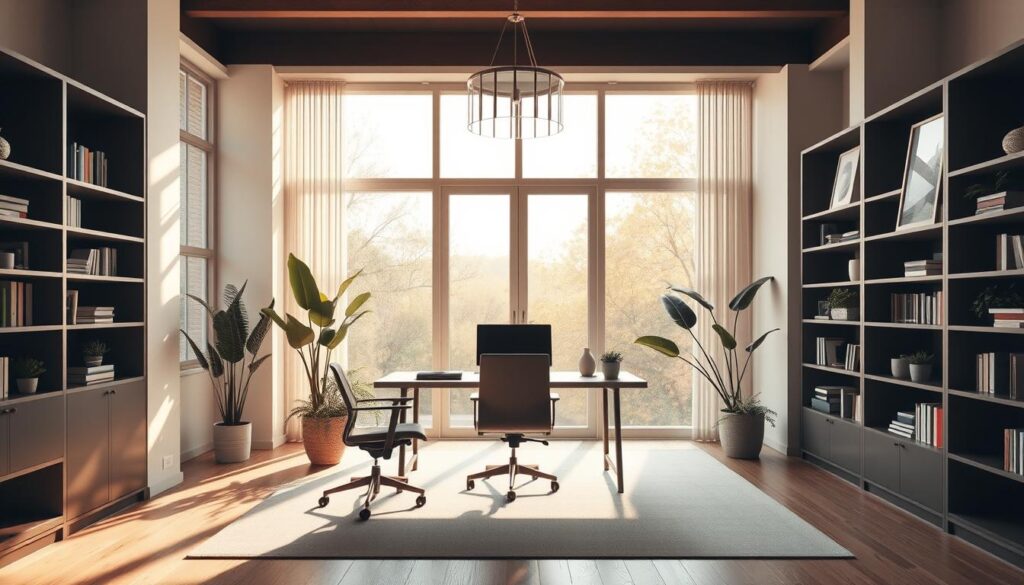
Choosing the Right Fixtures
Picking the right lighting fixtures is crucial. Match your fixtures to your office’s style and size. For a stylish home office design, sleek, modern fixtures work well with your decor.
| Fixture Type | Purpose | Style Consideration |
|---|---|---|
| Desk Lamp | Task Lighting | Modern, Adjustable |
| Floor Lamp | Ambient Lighting | Sleek, Minimalist |
| Ceiling Light | General Lighting | Simple, Elegant |
Layering Light for Functionality
Layering light means using various sources for a great workspace. This includes overhead, task, and accent lights. It makes your office bright and welcoming, perfect for work.
“The way we light our spaces can dramatically change the way we feel and work.” – Lighting Expert
With these lighting tips, your home office will be both useful and stylish. It will show off your personal taste, using valuable office interior design tips for a stylish home office design.
Budgeting for Your Home Office Design
Effective budgeting is key to bringing your home office design ideas to life. A well-planned budget helps you make the most of your resources. This ensures your home office is both functional and aesthetically pleasing, reflecting good interior design of home office principles.
Assessing Costs
When assessing costs, consider the essential furniture and equipment needed for your home office. This includes an ergonomic office chair and desk, adequate lighting, and necessary technology such as a computer and printer.
| Item | Low-End Cost | High-End Cost |
|---|---|---|
| Ergonomic Desk | $200 | $1,000 |
| Office Chair | $100 | $500 |
| Lighting | $50 | $200 |
Saving Strategies
To save money while designing your home office, consider repurposing or refurbishing existing furniture. Shopping during sales or using second-hand stores can also help reduce costs. Focusing on home office organization solutions can help minimize the need for additional storage units, saving money.
Prioritizing Features
Prioritizing features within your budget is crucial. Identify the elements that are most important to your productivity and comfort, and allocate your budget. For instance, if you spend a lot of time on your computer, investing in a high-quality, ergonomic chair and desk may be a priority.
By carefully assessing costs, employing saving strategies, and prioritizing features, you can create a home office that meets your needs without exceeding your budget.
Maintaining an Organized Workspace
A clutter-free workspace is key to staying focused and reaching your goals. An organized home office boosts productivity, lowers stress, and makes work better overall.
Tips for Decluttering
Decluttering is the first step to an organized space. Begin by removing things you don’t need from your home office. Sort items into keep, donate, or throw away piles. If you haven’t used it in a year, you probably won’t miss it.
- Sort items into categories.
- Get rid of unnecessary paperwork and documents.
- Donate or recycle items that are still in good condition.
Organizing Supplies and Documents
After decluttering, organize what’s left. Use storage like file cabinets, shelves, and desk organizers to keep things neat. Set up a filing system for both physical and digital documents for easy access.
- Use a filing cabinet for important documents.
- Implement a digital filing system for easy access.
- Utilize desk organizers for office supplies.
Regular Maintenance Routines
To keep your space organized, create regular cleaning routines. Set aside time each week for tidying up. Also, plan regular decluttering sessions to stay organized.
Tips for Regular Maintenance:
- Schedule weekly tidying sessions.
- Regularly review and update your filing system.
- Keep your workspace clean and dust-free.
By sticking to these tips, you can enjoy a more productive and stress-free home office. Our creative workspace design and modern home office inspiration will help you find the perfect mix of function and style.
Future-Proofing Your Home Office Design
As we finish our guide to the perfect home office, thinking about the future is key. A good home office should grow with you, using stylish designs that last. This way, your space stays useful and looks great for years.
Adapting to Evolving Requirements
To make your home office future-ready, look into the newest office design tips. Think about using modular furniture or spaces that can do many things. These ideas help your office stay flexible and useful.
Staying Current with Design Trends
Home office designs are always changing. Keeping up with trends like green materials and smart tech is important. It makes your space both functional and stylish.
Planning for the Future
By adding these features and thinking about your future needs, you’ll have a home office that keeps up. Good planning and a focus on design that works and looks good will keep your office a great place to work.

